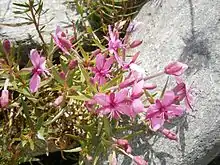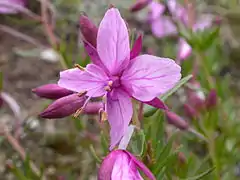Chamaenerion fleischeri
Chamaenerion fleischeri, formerly Epilobium fleischeri, commonly known as Alpine willowherb, is a herbaceous perennial plant of the family Onagraceae.
| Chamaenerion fleischeri | |
|---|---|
 | |
| Flowers of Chamaenerion fleischeri | |
| Scientific classification | |
| Kingdom: | Plantae |
| Clade: | Tracheophytes |
| Clade: | Angiosperms |
| Clade: | Eudicots |
| Clade: | Rosids |
| Order: | Myrtales |
| Family: | Onagraceae |
| Genus: | Chamaenerion |
| Species: | C. fleischeri |
| Binomial name | |
| Chamaenerion fleischeri | |
| Synonyms[1][2][3] | |
|
List
| |
Description

The biological life-form of Chamaenerion fleischeri is scapose hemicryptophyte,[4] as its overwintering buds are situated just below the soil surface and the floral axis is more or less erect with a few leaves. This plant reaches on average 10–40 centimetres (3.9–15.7 in) in height. The stem is erect and the leaves are usually glabrous and toothed.[4] This plant is quite similar to Chamaenerion dodonaei, but that is much taller and has bristly leaves.[4]
Chamaenerion fleischeri has fragrant flowers with four pointed thin dark purple sepals and four bright pink ovate petals. Flowering occurs from late June to August.[4]
Habitat
It grows in clusters on moraines, in glaciers, among piles of stones and in alluvial deposits. It prefers siliceous soils, at an altitude of 600–2,700 metres (2,000–8,900 ft) above sea level.[4]
Gallery
 Plant of Chamaenerion fleischeri
Plant of Chamaenerion fleischeri Plant of Chamaenerion fleischeri
Plant of Chamaenerion fleischeri Flowers of Chamaenerion fleischeri
Flowers of Chamaenerion fleischeri
References
- International Plant Names Index
- Flore Alpes.com
- Biolib
- Pignatti S. - Flora d'Italia – Edagricole – 1982. Vol. II, pag. 155